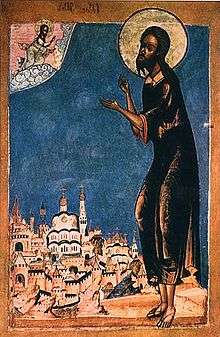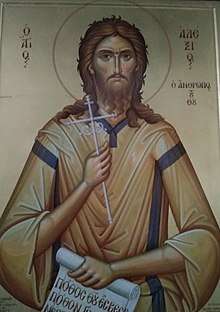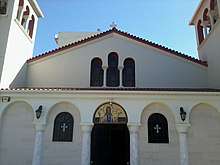Alexius of Rome
| Alexis of Rome | |
|---|---|
 Saint Alexius | |
| Confessor | |
| Born |
4th Century Rome, Roman Empire |
| Died |
5th Century Rome, Roman Empire |
| Venerated in | Roman Catholic Church; Eastern Orthodox Church; Byzantine Catholic Churches; Syriac Orthodox Church; Armenian Orthodox Church; Maronites; Syriac Catholic Church; Armenian Catholic Church |
| Canonized | Pre-Congregation |
| Major shrine | Monastery of Agia Lavra, Kalavryta |
| Feast | 17 July in the West; 17 March in the East |
| Attributes | holding a ladder; man lying beneath a staircase |
| Patronage | Alexians; beggars; belt makers; nurses; pilgrims; travellers; Kalavryta |
Saint Alexius or Alexis of Rome or Alexis of Edessa (Greek: Όσιος Αλέξιος) was a fourth-century monastic who lived in anonymity and is known for his dedication to Christ. There are two versions of his life that are known to us, a Syriac one and a Greek one.
Syriac version
According to Syriac tradition St. Alexius was an Eastern saint whose veneration was later transplanted to Rome. The relocation of the veneration to Rome was facilitated by the belief that the saint was a native of Rome and had died there. This Roman connection stemmed from an earlier Syriac legend which recounted that during the episcopate of Bishop Rabbula (412–435) a "Man of God" who lived in Edessa, Mesopotamia, as a beggar, and who shared the alms he received with other poor people, was found to be a native of Rome after his death.[1]
Greek version

The Greek version of his legend made Alexius the only son of Euphemianus, a wealthy Christian Roman of the senatorial class. Alexius fled his arranged marriage to follow his holy vocation. Disguised as a beggar, he lived near Edessa in Syria, accepting alms even from his own household slaves, who had been sent to look for him but did not recognize him,[2] until a miraculous icon of the Blessed Virgin Mary (later this image was called Madonna of St.Alexius) singled him out as a "Man of God." (Greek: Άνθρωπος του Θεού)
Fleeing the resultant notoriety, he returned to Rome, so changed that his parents did not recognize him, but as good Christians took him in and sheltered him for seventeen years, which he spent in a dark cubbyhole beneath the stairs, praying and teaching catechism to children.[2] After his death, his family found writings on his body which told them who he was and how he had lived his life of penance from the day of his wedding, for the love of God.
Veneration
Alexius seems to have been completely unknown in the West prior to the end of the tenth century. Only from the end of the 10th century did his name begin to appear in any liturgical books there.
Since before the 8th century, there was on the Aventine in Rome a church that was dedicated to St Boniface. In 972 Pope Benedict VII transferred this almost abandoned church to the exiled Greek metropolitan, Sergius of Damascus. The latter erected beside the church a monastery for Greek and Latin monks, soon made famous for the austere life of its inmates. To the name of St Boniface was now added that of St Alexius as titular saint of the church and monastery known as Santi Bonifacio e Alessio. It is evidently Sergius and his monks who brought to Rome the veneration of Saint Alexius. The Eastern saint, according to his legend a native of Rome, was soon very popular with the folk of that city..[1] This church, being associated with the legend, was considered to be built on the site of the home that Alexius returned to from Edessa.
St. Alexius is mentioned in the Roman Martyrology under 17 July in the following terms: "At Rome, in a church on the Aventine Hill, a man of God is celebrated under the name of Alexius, who, as reported by tradition, abandoned his wealthy home, for the sake of becoming poor and to beg for alms unrecognized."[3]
While the Roman Catholic Church continues to recognize St. Alexius as a saint, his feast was removed from the General Roman Calendar in 1969. The reason given was the legendary character of the written life of the saint[4] Johann Peter Kirsch remarked: "Perhaps the only basis for the story is the fact that a certain pious ascetic at Edessa lived the life of a beggar and was later venerated as a saint."[1]
The Tridentine Calendar gave his feast day the rank of "Simple" but by 1862 it had become a "Semidouble" and, in Rome itself, a "Double".[5] It was reduced again to the rank of "Simple" in 1955[6] and in 1960 became a "Commemoration".[7] According to the rules in the present-day Roman Missal, the saint may now be celebrated everywhere on his feast day with a "Memorial", unless in some locality an obligatory celebration is assigned to that day.[8]
The Eastern Orthodox Church venerates St Alexius on 17 March[9][10]. Five Byzantine Emperors, four Emperors of Trebizond and numerous other eastern European and Russian personalities have borne his name; see Alexius. There are numerous churches bearing his name in Greece and Russia but also the other orthodox countries. Saint Alexius is well known to the region of north Peloponnese because of the honorable skull of the Saint which is kept in the monastery of Agia Lavra. Churches dedicated to St. Alexius are found in Aigio and Patras.

Relics
Relics of Saint Alexius are found in some churches and monasteries in Greece like Esphigmenou monastery, mount Athos and Dormition of Theotokos Monastery, Boeotia. In Russia relics of St. Alexius are kept in the Alexander Nevsky Lavra in Saint Petersburg. In Cyprys relics are kept in the Kykkos Monastery. The most precious relic is a large part of the honorable skull of the Saint which is kept in the monastery of Agia Lavra near in Kalavrita, Greece. According to the Ktetorikon (monastic foundation codex) of the monastery, the honorable skull was donated to the monastery by the Byzantine emperor Manuel II Palaiologos in 1398 (this is also the inscription on the reliquary).[11][12][13][14]
References to St. Alexius

- Saint Alexis Parish and School, located in Wexford, Pennsylvania, is named for St Alexius.
- Stefano Landi wrote an opera about him (1632).
- Camilla de Rossi wrote an oratorio about him (1710).
- Rimsky-Korsakov wrote a secular cantata about him.
- Alexander Radishchev, in his Journey from St Petersburg to Moscow (1790), refers to the story of St Alexis as sung by a blind soldier begging in Klin, near Moscow.
- Mikhail Kuzmin wrote a play ("Komediia o Aleksee cheloveke bozhyem" - comedy about Alexis, the Man of God) about the life of St. Alexis.
- In 1769, San Elijo Lagoon and beach in San Diego County, California were named San Alejo by the Portola Expedition for Saint Alexius. The spelling changed in later years to Elijo.
St Alexius is also the Patron Saint of the religious institute known as the Alexians and of the town of Kalavryta in Greece.
The tale of St Alexius has parallels with that of The Prodigal Son, as told in the biblical Book of Luke. As it appears in Legenda aurea[15] (later retold in the Gesta Romanorum[16]).
Gallery
References
- 1 2 3

- 1 2 "Saint Alexius of Rome", Magnificat
- ↑ "Martyrologium Romanum" (Libreria Editrice Vaticana, 2001) ISBN 88-209-7210-7
- ↑ "Calendarium Romanum" (Libreria Editrice Vaticana, 1969) page 130
- ↑ Missale Romanum 1862
- ↑ General Roman Calendar of Pope Pius XII
- ↑ General Roman Calendar of 1960
- ↑ General Instruction of the Roman Missal Archived July 20, 2008, at the Wayback Machine., 355 c
- ↑ Neon anthologion plerestaton te kai akribestaton... Rome, Typographia Vaticana, 1598
- ↑ Mēnologion tōn euangelión heortastikon Sive Kalendarivm Ecclesiae Constantinopolitanae , Stefano Antonio Morcelli, 1788 (available online in books.google.com)
- ↑ Agia Lavra monastery in Kalavrita, texts from the codices of the monastery, Kostas Lappas, 1975 (in Greek) Online access from the website of National Hellenic Research Foundation
- ↑ Hagia Lavra Monastery Greek monasteries website monastiria.gr
- ↑ Monastery of Holy Lavra, article in OrthodoxWiki
- ↑ Ακολουθία και βίος του οσίου και Θεοφόρου Πατρός Ημών Αλεξίου του ανθρώπου του Θεού : ψαλλομένη τη ΙΖ' Μαρτίου, εν ή τελείται η μνήμη αυτού (Life and hymns of Saint Alexius man of God , chanted in 17 March ,Printed in Patras, 1875 (online access in the digital library of the university of Crete)
- ↑ Voragine (trans. W Caxton), The Golden Legend (London, 1483) chapter VI, p 96.
- ↑ C Swan (trans.), Gesta Romanum (London, 1888) p.32ff. In a note Swan lambasts the tale, as describing "the prevailing tenets of popery". The ethics of the central character are criticised severely: "He who neglects every relative duty; he who is a cruel and ungrateful son, a bad husband, and careless master; he whose whole life is to consume time, not to employ it - to vegetate but not to exist - to dream away life, with every sense locked up...[etc.]...THIS is to be a Man of God?" (Swan's emphasis); ibid, p.363)
Bibliography
- Holweck, F. G., "A Biographical Dictionary of the Saints", St. Louis, Missouri: B. Herder Book Co., 1924.
External links
| Wikimedia Commons has media related to Alexius of Rome. |

- Brief vita, based on Little Pictorial Lives of the Saints, a compilation of Butler's Lives of the Saints
- Venerable Alexis the Man of God, The Orthodox Church in America
- St Alexis Parish
Austrian author Peter Handke's novel OBSTDIEBIN/ FRUIT THIEF features ALEXIA a girl re-incarnation of ALEXIUS http://handke-magazin.blogspot.com/2018/04/main-character-device-alexia-fruit.html
http://handke-discussion.blogspot.com/2018/03/roloffs-review-of-alexia-fruit-thief.html
